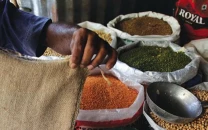Narayan Pura: symbol of resilience and community spirit
The oldest minority neghbourhood in the metropolis marks its centenary

Narayan Pura, the oldest locality of the minority Hindu community in the Ranchore Line neighbourhood of central Karachi, is marking its centenary.
"This marks the seventh generation of our presence in this area. For decades, our families have dedicated themselves to serving the city, often neglecting our own health, education, and well-being, all while continuing to dutifully pay rent to the government," says Hardas, a community member who was born and raised in Narayan Pura and retired after serving in the Karachi Metropolitan Corporation (KMC) for over 30 years.
Narayan Pura stands as a symbol of resilience and community spirit. Established in 1924 by the visionary Hindu philanthropist Narayan Das Bechal Acharya, this settlement was originally intended to house the workers of Karachi Municipal Corporation, now known as the Karachi Metropolitan Corporation.
"He was not just a leader at the KMC, he was a true humanitarian," says Hardas while reminiscing about Acharya.
The genesis of Narayan Pura can be traced back to the recommendations of Jamshed Nusserwanjee Mehta, Karachi's first elected mayor and revered as the Father of Karachi. Though the specifics of its establishment were communicated verbally among officials, the settlement flourished over the years, now comprising over 4,000 structures and housing a diverse community of Hindus, Christians, and Sikhs.
This neighbourhood has four entrances and 17 blocks, where generations of minority communities have coexisted harmoniously for over a century. Narayan Pura remains a beacon of religious diversity and unity, boasting six Hindu temples, two churches, and a gurdwara. "We take pride in our ability to come together to celebrate our religious festivals," shares Ashok Athwal, highlighting the bond that transcends religious boundaries.
However, beneath the surface lies a struggle for basic amenities and rights. Residents, burdened with increasing rents, reminisce about a time when the KMC shouldered maintenance responsibilities. Once paying nominal rents, residents now make monthly payments ranging from Rs4,000 to Rs4,500.
Kirshan, a Narayan Pura resident, reminisces about his father's era when rents were a fraction of the current rates. "The KMC used to shoulder maintenance responsibilities until 1985, providing some respite during our annual festivals like Holi and Diwali," he recalls.
Despite repeated pleas and petitions, ownership rights remain elusive for the residents of this old working-class neighbourhood. "During election campaigns, politicians promise us the moon, only to forget our plight afterwards," laments another resident, Maharaj.
"We implore the government to recognise our longstanding presence and grant us the ownership rights we deserve," says Maharaj, echoing a sentiment shared by many residents.
"We are simply too poor to afford homes elsewhere and pay exorbitant rents," argues another resident, highlighting the stark reality faced by many in the community.
As Narayan Pura grapples with urbanisation and neglect, its residents face challenges of encroachment and economic hardship. Yet, amidst these struggles, the community's spirit remains unbroken. Narrow streets, bustling with life, bear witness to the resilience and fortitude of Narayan Pura's people, reflecting the enduring culture and camaraderie of this historic settlement.
Published in The Express Tribune, April 15th, 2024.



















COMMENTS
Comments are moderated and generally will be posted if they are on-topic and not abusive.
For more information, please see our Comments FAQ